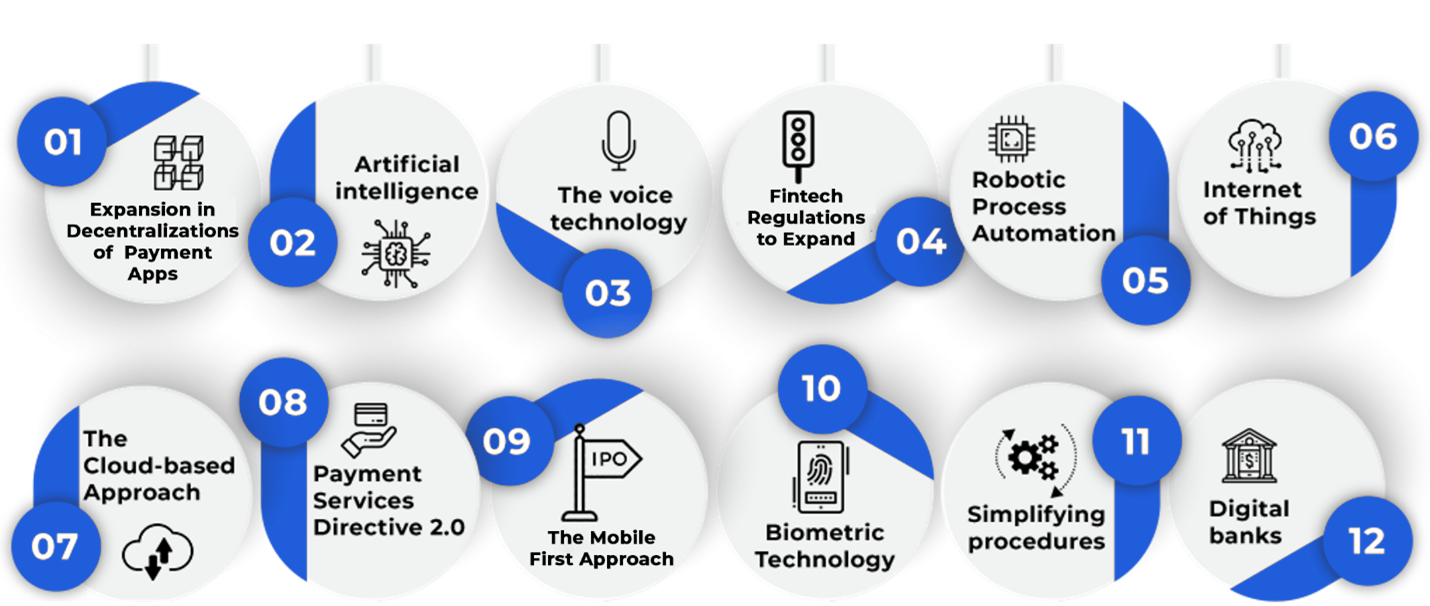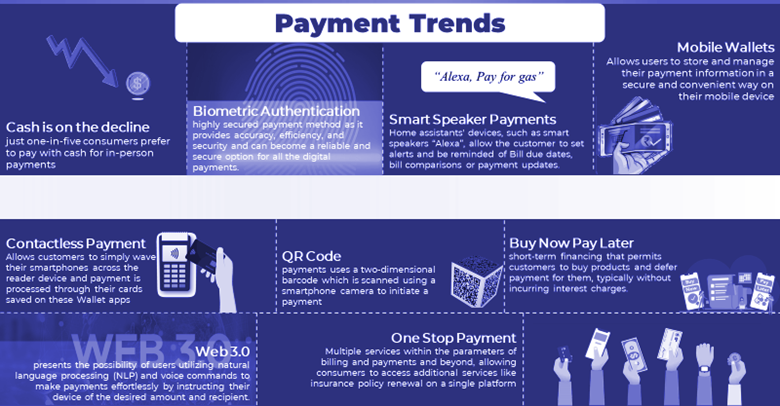Payment Trends 2023: Here's How the Payment Landscape is Emerging
Economics, monetary systems, and payment methods have experienced profound transformations throughout history. From the barter system to the introduction of currency notes, the transition to physical cash transactions, and now the era of digital cashless payments, each transition represents a pivotal juncture in our societal evolution. The earlier rudimentary methods harken back to our formative stages, while today's technology-driven payment systems stand as a testament to the remarkable progress of our contemporary world.
In this blog, we will explore the evolving payment landscape in 2023, shedding light on emerging trends that are reshaping the industry. Innovations like blockchain-based payment transactions, payments facilitated through smart speakers, the Buy Now, Pay Later (BNPL) model, and other AI/ML embedded offerings are ushering in a new era of modern digital payments. Simultaneously, these advancements are addressing organizations' challenges related to operational resilience, providing a comprehensive look at the current state of payment technology.
We'll also explore what lies ahead for the payments industry in the immediate future, including:
- The innovative new technology trends
- The permanent changes in customer behavior
- The emergence of next-gen payment services, and the increased focus on nimble payment apps and solutions for B2B and SMB segments.
- The ways in which global institutions need to adapt
But first, Who is the New Age Customer?
With the rise of digital AI/ML mobile payment apps, customers expect consistent digital payments experience across all their devices and platforms. This includes frictionless payment methods, real time payments, digital wallets, mobile banking and much more. This modern digital consumer operates with elevated expectations, craving personalized encounters and leaning heavily on advanced technologies. They actively pursue interactions that are both effortlessly smooth and tailored to their needs, all while placing a premium on the trustworthiness of their digital engagements.
Quick Fact
The 82 percent of Americans using digital payments—defined to include browser-based or in-app online purchases, in-store checkout using a mobile phone and/or QR code, and person-to-person (P2P) payments—in 2021 exceeds last year's 78 percent and the 72 percent of five years ago.
What is it that the provider should do?
In response to emerging payment trends mentioned below, providers should take proactive measures to cater to evolving customer demands. This entails implementing seamless and secure real-time payment systems, integrating advanced technologies such as blockchain and IoT, and delivering personalized experiences. Additionally, prioritizing robust cybersecurity measures is crucial to ensure the protection of customer data and transactions, fostering trust and confidence in adopting these innovative payment solutions.
To meet these needs, providers require their payment platform to deliver critical capabilities such as multi-channel payment processing, seamless integration with other systems, flexible payment options, robust security, and advanced analytics capabilities.
Here are some of the most critical capabilities that the companies need their payment platform to deliver:
- Real-Time Data and Analytics: The imperative to provide cutting-edge analytics technology is evident, enabling personalized user journeys, the detection of fraudulent activities, and the automation of critical processes.
- New Payment Infrastructure: The evolution towards an omnichannel, personalized, and seamless payment ecosystem is in full swing, encompassing 24/7 real-time payment processing, advanced data analytics and sharing capabilities, and the adoption of cloud delivery models.
- Global Compliance Focus: Particular emphasis on data privacy, security, and tax regulations that vary across jurisdictions.
- Utilizing AI and ML: The utilization of Artificial Intelligence (AI) and Machine Learning (ML) technologies holds the promise of personalization, rapidity, security enhancements, data-driven insights, and seamless integrations. These advancements enable businesses to achieve greater efficiency and intelligence while optimizing resource utilization.

Decoding the top payment trends in 2023 that will shape how businesses and consumers interact
Trend 1: Contactless and Mobile Transactions
According to a study, contactless transactions are expected to grow to $10 trillion globally by 2027, from $4.6 trillion in 2022. A key element of this transition is a society-wide push toward cashless transactions, coupled with the increase and improvement in mobile and wearable devices. Shifting toward such contactless payment solutions has provided a fast and highly convenient way for consumers to pay. Allows customers to simply wave their smartphones across the reader device and payment is processed through their cards saved on these Wallet apps.
Trend 2: Increased focus on data security
With the jump in digital payments, a parallel jump in payment scams and data theft is inevitable. While the fight against fraudsters and scammers has given results over the last few years and has effectively pushed back card fraud, cybercriminals are constantly coming up with new types of fraud and are keeping the industry on edge.
As a result, payment service providers (PSPs) and financial institutions (FIs) are increasing their investments in payment infrastructure, with an emphasis on securing transactions throughout the lifecycle and protecting individuals' personally identifiable information (PII).
- Biometric authentication is expected to play a part in this, as fingerprint, voice and facial recognition, and even behavioral biometrics (including swiping, typing, and phone-holding patterns) are included in the process. Along with biometrics, digital IDs will also increasingly come to serve as a way of authentication or as an additional security layer on top of others.
- Apart from threats, data security compliance is further prompted by the increase in regulatory requirements. Gartner expects that by the end of 2024 around “75% of the world's population will have its personal data covered under modern privacy regulations”. This will come true, as the use of tokens in already helping in separating personally identifiable information (PII) from other types of data will surely play a critical role. Tokenization has already allowed businesses to protect customer data and remain compliant while still being able to use data to gain insight into customer behavior and experience.
- Finally, the rollout of the ISO 20022 standard in March 2023 will also support the interoperability between different payment systems while enabling transparency, accuracy, and compliance.
Trend 3: Innovative Ways of Payments
With the move to digital, payment services are available to customers on a 24/7 basis, all year round, offering speedy, secure payments with decreased load time. The shift to digital provides the benefit of superior payment management, maintaining digital records of transactions, and using the data to engage with the customers intelligently. Providers also introduce unique payment plans, such as low-income credit plans, automatic payments, payment extensions, and level pay, that consumers easily avail themselves of through digital channels.
- Securely and seamlessly leverage the modern payment channels to boost customer adoption.- Bring Credit Cards, ACH, Text-to-pay, Wallets, Apple Pay, G-Pay, PayPal etc., to the payments ecosystem. Make arrangements for One-Time Payments, AutoPay, and other flexible payment plans with 24/7 support and assistance.
- AI/ML technology - enable real-time transactions to balance supply and demand- Many providers are exploring the potential of AI/ML technology to create both internal and industry-wide efficiencies. The technology enables “trustful and secure” transactions ruled by incorruptible algorithms. Organizations are seeking to transform the billing experience by the unification of billing statements, transparency of data, and one-click payment mode via mobile platform.
- Adapting New ways to Pay
Aside the current usage of mobile digital wallets, some fresh and new-bee trends & innovations are making headway
According to a recent report, nearly half of the consumers (44%) have changed their payment habits for this reason, with two-fifths (41%) of these using digital wallets more than they did a year ago. 25% of consumers said they are using digital wallets more to pay online than they were 12 months ago, behind only debit cards (36%) and credit cards (28%).
- Smart Speaker Payments - Home assistants' devices, such as smart speakers “Alexa”, allow the customer to set alerts and be reminded of Bill due dates, bill comparisons or payment updates. Once the connection is set up, it can handle a bill payment with a request like “Alexa, pay my bill” or any other available bill options.
- One Click Payments - Customer/Cardholder saves their card details on file, which are tokenized, and then the card can be charged without additional authentication whenever the user hits a “pay”/” buy” button or carries out other action defined as a payment trigger on the shopping site or in an app.
- Mobile Wallets - Allows users to store and manage their payment information in a secure and convenient way on their mobile device. Instead of carrying a physical wallet, users can use their mobile wallet to make payments at participating merchants or transfer money. They use a range of security measures to protect users' financial information, such as encryption, tokenization, and biometric authentication. Popular mobile wallets include Apple Pay, Google Pay, Samsung Pay, and PayPal.
- QR Codes/Kiosks - QR code payments uses a two-dimensional barcode which is scanned using a smartphone camera to initiate a payment.
- Kiosks - Self-service machines that allow customers to make payments using cash, cards, or mobile devices. Where customers typically select the payment option and follow the on-screen prompts to complete the transaction.

To keep up with the rising demand for convenient, secure, and efficient payment processes, it is now imperative for organizations to cater to the new digital customer, encompassing these trends and adopt digital payment eco-system.
By doing so, they can not only improve their operational and financial performance but also provide superior customer experience.
How iPaySmart can help you stay on top of payment trends in 2023?
With all these developments, providers may find themselves wondering how to meet consumer demands. This is where partnering with a reliable payment service provider who stays on top of online payments trends is key.
Want to give iPaySmart a try?
Leave us a message on what is your ask and our payment expert will get in touch with you.
How iPaySmart can help?
iPaySmart is the industry’s trusted and proven AI-Powered Vertical Specific Digital Customer Experience Payment Platform. Our integrated platform is designed to facilitate seamless, secure payments, while also automating billing processes and offering a range of payment options. The comprehensive platform is augmented by advanced analytics, driving improved revenue streams and enhancing overall customer satisfaction.
Our integrated platform streamlines the entire payment collection and validation process, offering automation, configurability, and scalability for an optimized billing and payment CX experience. We take pride in setting a new industry standard for payment solutions, benefiting businesses of all sizes.




